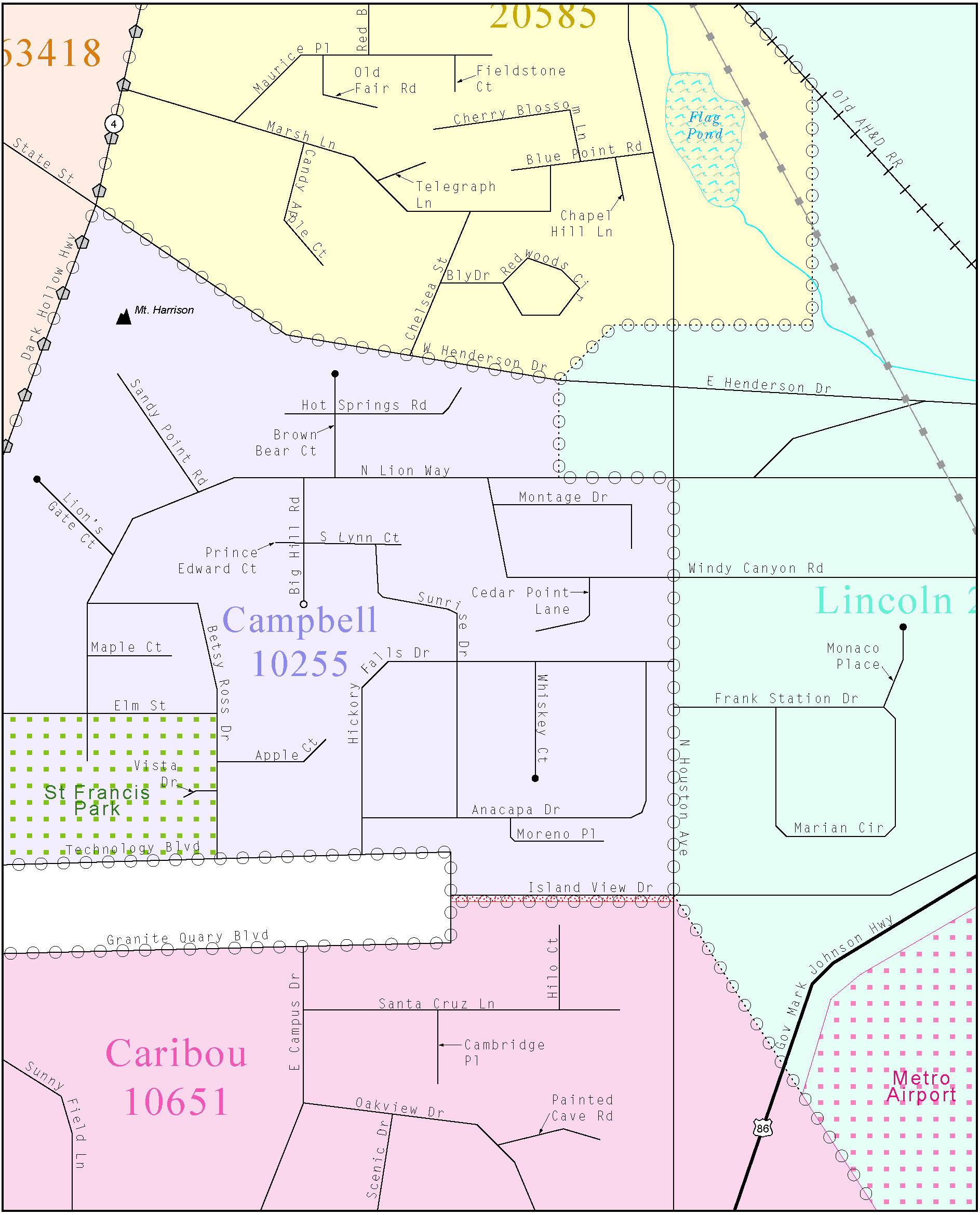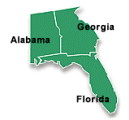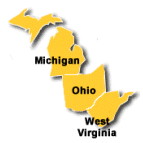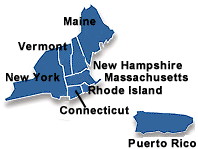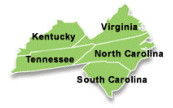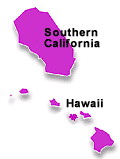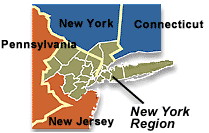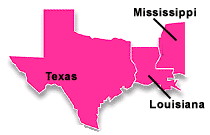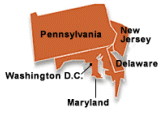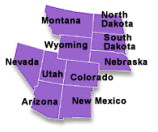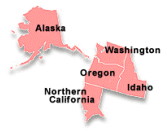The Boundary and Annexation Survey (BAS)
The Boundary and Annexation Survey (BAS)
06_Attachment D1_Paper_Local
The Boundary and Annexation Survey (BAS)
OMB: 0607-0151
Boundary and Annexation SurveyPaper Respondent Guide |
Issued June 2007 |
|
|
|
|
Table of Contents
1.0 Introduction to the Boundary and Annexation Survey 1
1.2 Specific state arrangements and agreements 1
1.4 Key dates for BAS respondents 1
2.0 Updating the BAS Materials 2
2.1 Reviewing and Updating Your Form 2
2.2 Making Changes and Corrections to Your Maps 5
2.2.1 Explanation of map symbology 7
2.2.2 Legal Boundary Changes versus Boundary Corrections 9
2.2.3 Legal Boundary Changes 9
2.2.4 Legal Boundary with Coincident Feature Change 13
2.2.6 Feature modifications 17
2.2.7 Inserting point and area features 18
2.2.8 Edits to street information 19
2.2.9 Adding feature names in a congested area 20
2.2.10 Correcting feature location 20
2.2.11 Correcting feature name 21
2.2.12 Annotating address breaks 22
2.2.14 Adding a cul-de-sac or circle 24
2.2.15 Designating a geographic corridor to a street feature 25
2.2.16 Designating a geographic offset to a street feature 26
3.0 Signing the Updated Maps 28
Appendix 1: Paperwork Reduction Project 30
Appendix 2: State arrangements and agreements 31
Appendix 3: Census Bureau Regional Offices - Contact Information 37
1.0 Introduction to the Boundary and Annexation Survey
1.1 Overview of the BAS
The U.S. Census Bureau conducts an annual survey called the Boundary and Annexation Survey (BAS) to collect information about selected legally defined geographic areas, such as counties (and equivalent areas), incorporated places, minor civil divisions (MCDs), as well as federally recognized American Indian reservations, including off-reservation trust lands and tribal subdivisions. The BAS also provides an opportunity for participants to review the names and geographic relationships for these areas. Title 13, U.S. Census Code authorizes this survey.
BAS information is used to provide a record for reporting the results of the decennial and economic censuses, and to support the Population Estimates Program and the American Community Survey. Maintaining correct boundaries and boundary-to-feature relationships through the BAS helps ensure that the appropriate population is assigned to each entity.
In compliance with the Office of Management and Budget Circular A-16, the BAS supports the Census Bureau’s spatial data steward responsibilities for the Federal Geographic Data Committee and the Geospatial One-Stop by updating the inventory of, and boundaries for, governmental units. In addition, the BAS is the source of up-to-date information on boundaries, codes, and names for the U.S. Geological Survey’s (USGS) National Map and the Geographic Names Information System. The BAS is also the source for changes in the boundary of incorporated places, MCDs, counties (and equivalent areas), and federally recognized American Indian Areas (AIAs), which include reservations and off-reservation trust lands.
1.2 Specific state arrangements and agreements
The Census Bureau has established a number of agreements with states for reporting boundary changes (see Appendix 2). It is very important that you review this section, since it may effect your submission. In addition, there are state specific requirements to submit your annexation to your individual states.
1.3 Legal disputes
If it comes to our attention that areas of land are in dispute between two or more jurisdictions, we will not make annexations or boundary corrections until the parties come to a written agreement, or there is a documented final court decision regarding the matter/dispute. If you have questions concerning this, please contact the Census Bureau Legal Office at 301-763-2918.
1.4 Key dates for BAS respondents
The packages must be received on or before April 1st at the Census Bureau’s National Processing Center to be reflected in the Population Estimates Program and the American Community Survey. If the Census Bureau receives your updates between April 2nd and May 31st, they will be included in your BAS materials next year.
To change your method of participation in BAS from MTPS to either paper or Digital BAS, you must notify the Census Bureau by February 15th. You can contact the Census Bureau by phone at (800) 972-5651 or by email at [email protected].
2.0 Updating the BAS Materials
There are six steps involved in updating the BAS materials, including:
Reviewing and updating (if necessary) the geographic information on the BAS form
Reviewing and annotating the map with boundary changes and corrections
Annotating feature changes, additions, or deletions on the map
Annotating the address breaks at the intersection of roads and boundaries
Signing the updated maps
Returning the updated maps and BAS forms
It is important that all questions on the BAS form are answered completely. If there are no changes to report, please return only the “No Change” postcard provided with your materials. Please do not return all of the materials. If there are changes, sign and return only the maps with changes. Return the completed BAS form(s) and updated map(s) within 15 days using the pre-addressed envelope or return label.
2.1 Reviewing and Updating Your BAS Form
Begin with a review of all information printed on your BAS form. Make corrections to pre-printed information as shown in the following examples, 2.1.1.1 through 2.1.1.3. If your governmental unit’s name is misspelled, cross out the error and clearly print the correctly spelled name beside it.
BAS-1 form for Incorporated Places respondents
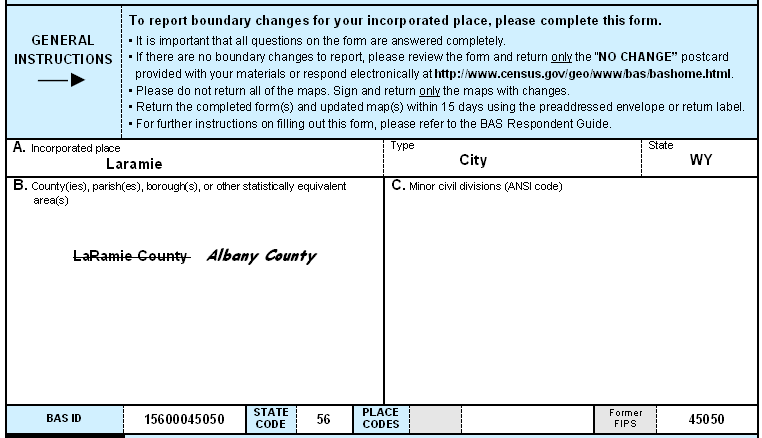
Example 2.1.1.1: Making corrections to the BAS-1 form for incorporated place
BAS-2 form for County respondents

Example 2.1.1.2: Making corrections to the BAS-2 form for county
BAS-3 form for MCD respondents

Example 2.1.1.3: Making corrections to the BAS-3 form for MCD
If you are reporting changes for any entity other than a county, complete question 1 and provide an effective date for name change or type change as shown in the following examples, 2.1.2.1 through 2.1.2.3.
BAS-1 form for Incorporated Places respondents
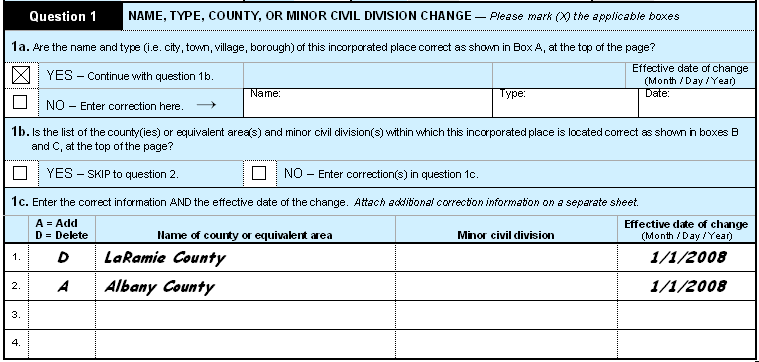
Example 2.1.2.1: Completing Question 1 from BAS-1 form for incorporated place
BAS-2 form for County respondents
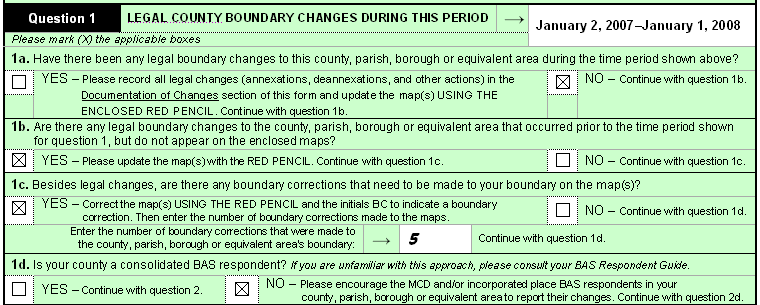
Example 2.1.2.2: Completing Question 1 from BAS-2 form for county
BAS-3 form for County respondents

Example 2.1.2.3: Completing Question 1 from BAS-1 form for MCD
Correct any information that needs to be changed, including:
Status of place, county or MCD (correct by checking the applicable box).
Governmental units, BAS mailing contact, BAS respondent or Highest Elected Official (correct by crossing out the incorrect information and clearly print the correction beside it).
Answer all questions pertaining to legal boundary changes and boundary corrections
2.2 Making Changes and Corrections to Your Maps
This section includes general guidelines and detailed examples illustrating how to update boundary and feature information. There are a number of general guidelines for changes and corrections to your maps:
Compare the BAS maps to a local source for your entity. Update the map(s) if the boundary shown does not correctly depict the boundary in effect as of January 1 of the survey year. If your county has multiple changes when recording on the BAS form, group the data entries by entity and within entity by type of change.
In addition to providing updates as of January 1st for the current survey year, you may provide annexations and de-annexations from previous BAS years. The legal documentation is required when submitting these updates.
Refer to the following example on the distinctions between a legal boundary change and a boundary correction.
Regarding feature and address changes and/or update information, although the BAS collects legal boundary information, the survey also accepts feature updates. Follow the steps below and be sure to use the enclosed purple pencil for feature updates.
The Census Bureau is undertaking a nationwide program to improve the positional accuracy of all streets and other features that appear in the Census Bureau’s digital database. It is not necessary to make small positional corrections on the BAS maps; correct only those streets that are significantly mis-located, or new streets that are related to the location of a new boundary.
Do not make changes on the index map. Index maps are provided as a reference to help you quickly locate a map sheet. If you received only an index map for your county, incorporated place, or MCD and you need to make boundary changes and/or feature updates, call (800) 972-5651 or e-mail [email protected] to request the individual map sheet(s) needed or a full set of maps.
The following examples are provided to illustrate how to update your boundary and feature information with the Census Bureau, including:
Explanation of map symbology
Legal boundary changes versus boundary corrections
Legal boundary changes
Legal boundary with coincident feature change
Boundary corrections
Feature modifications
Inserting point and area features
Edits to street information
Adding feature names in a congested area
Correcting feature location
Correcting feature name
Annotating address breaks
Deleting a feature
Adding a cul-de-sac or circle
Identifying a geographic corridor to the north and south of the street feature
Identifying a geographic offset to the north of the street feature
Unnamed roads
2.2.1 Explanation of map symbology
This section provides examples of the BAS map symbology. You can review this symbology and BAS map legend online at the following Web site:
http://www.census.gov/geo/www/bas/bashome.html
If you need further information or a copy of the legend mailed to you, please contact the Census Bureau by phone at (800) 972-5651 or by email at [email protected].
The following example shows the different boundary symbols used on the BAS maps:
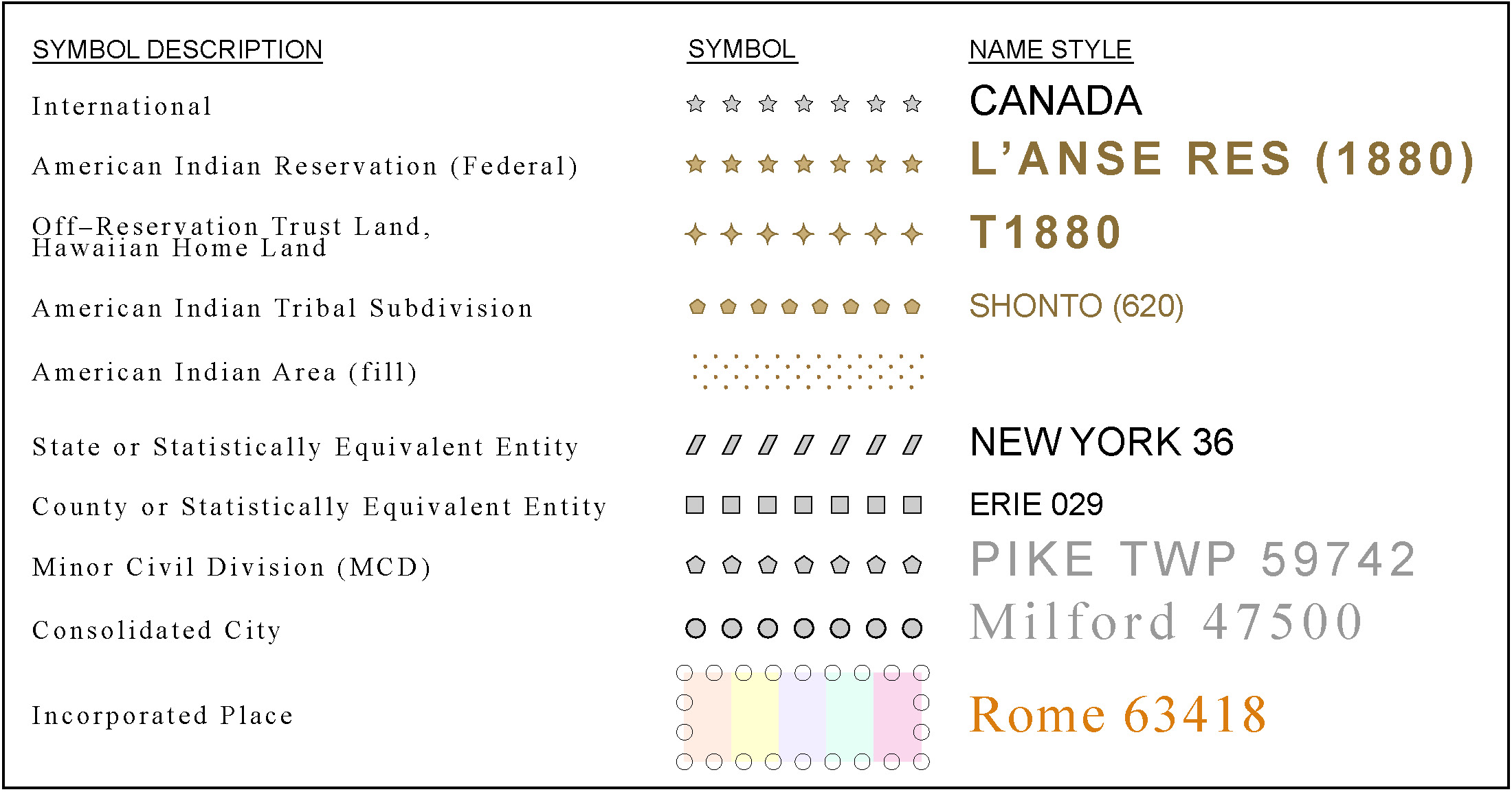
Example 2.2.1.1: Boundary symbology
In Example 2.2.1.2 below, incorporated place “Rome” is the subject area. If you are a place, your subject area will have no fill (ie, will be white). Neighboring places (ie, non-subject place areas) are represented by color fill. Non-subject places, counties and MCDs are delineated by their respective boundary symbols. Note that all areas outside of the subject area are considered fringe areas. Fringe areas are shaded with a gray dot pattern.
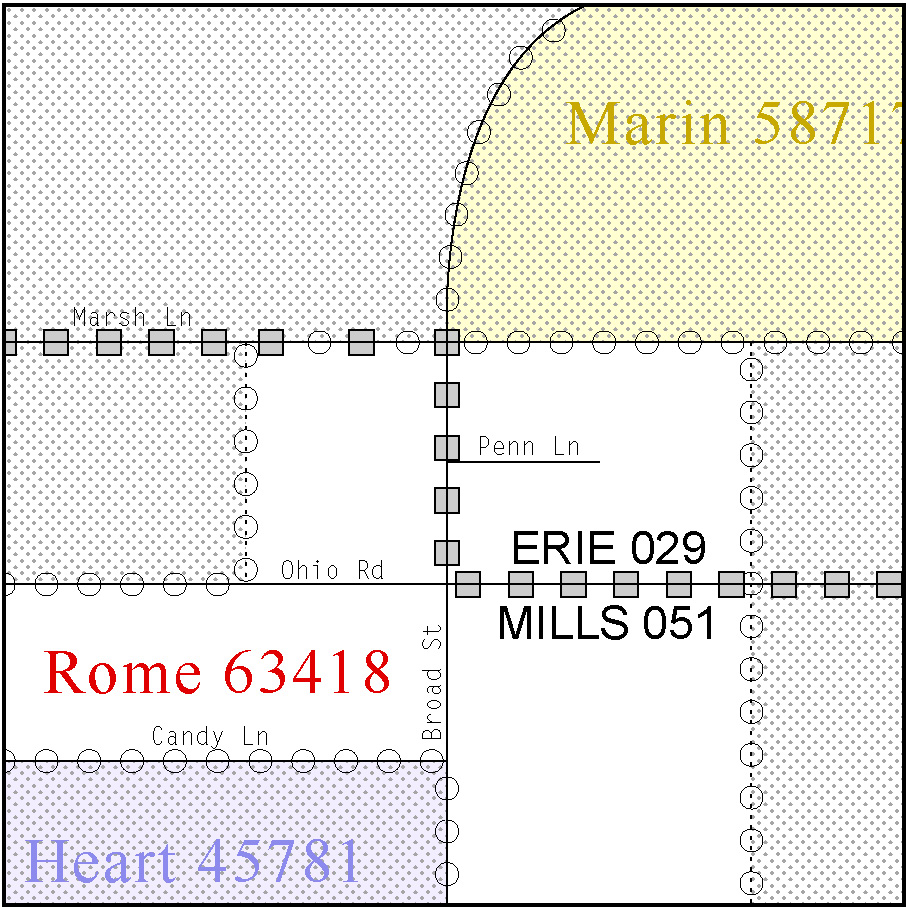
Example 2.2.1.2: Incorporated place (Rome) is the subject area with neighboring fringe areas shaded in gray.
In Example 2.2.1.3, “Mills County” is the subject area. Incorporated places are represented by color fill. Neighboring places, counties and MCDs are delineated by their respective boundary symbols, as well. Note that all areas outside of the subject area are considered fringe areas. Fringe areas are shaded with a gray dot pattern. Since Mills County is the subject entity in this example, the portion of the incorporated place of Rome that falls within Erie County is shaded as fringe.
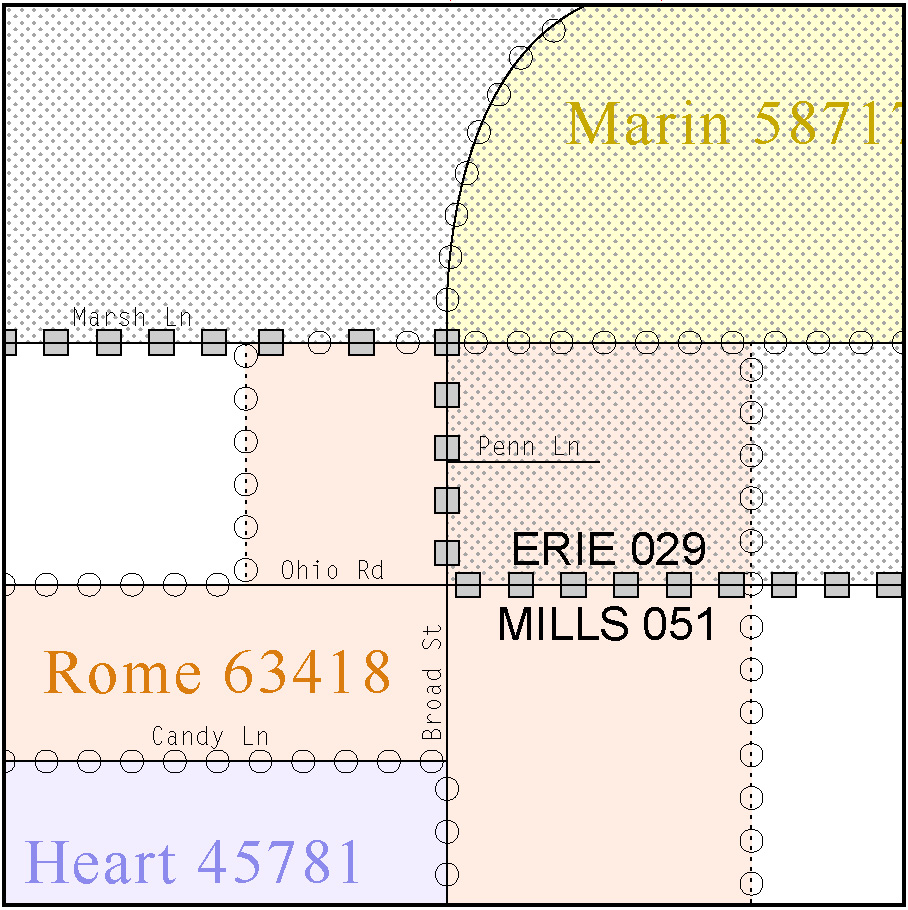
Example 2.2.1.3: Mills County is the subject area with neighboring fringe areas (including county, places and MCD) shaded in gray.
2.2.2 Legal boundary changes versus boundary corrections
The two types of modifications that can be made to a boundary, are: legal boundary changes and boundary corrections. A boundary change is an alteration to a boundary as a result of a legal action (i.e., ordinance). Reporting legal boundary changes is the primary goal of the BAS. A boundary correction is the adjustment of a boundary to correct an error in how the Census Bureau depicts an existing boundary and does not require legal documentation.
These figures illustrate how to make complete legal boundary changes, including annexations or de-annexations, to your maps and BAS form. Using the red pencil provided, you will cross out the portion of the boundary that is no longer current with a string of “Xs”. Draw the new boundary line(s) ensuring that you close your boundary and do not leave an incomplete boundary as shown in the figures. Add the ordinance number or other legal identifier of the action authorizing the change, along with the effective date of each annexation or de-annexation that you draw on the map.
Document these changes on the BAS form (included in your package) as shown below. If you are reporting for your incorporated place, follow example 2.2.3.2. If you are a reporting for your county, follow example 2.2.3.3. If you are reporting for your MCD, follow example 2.2.3.4.
Complete Boundary Change
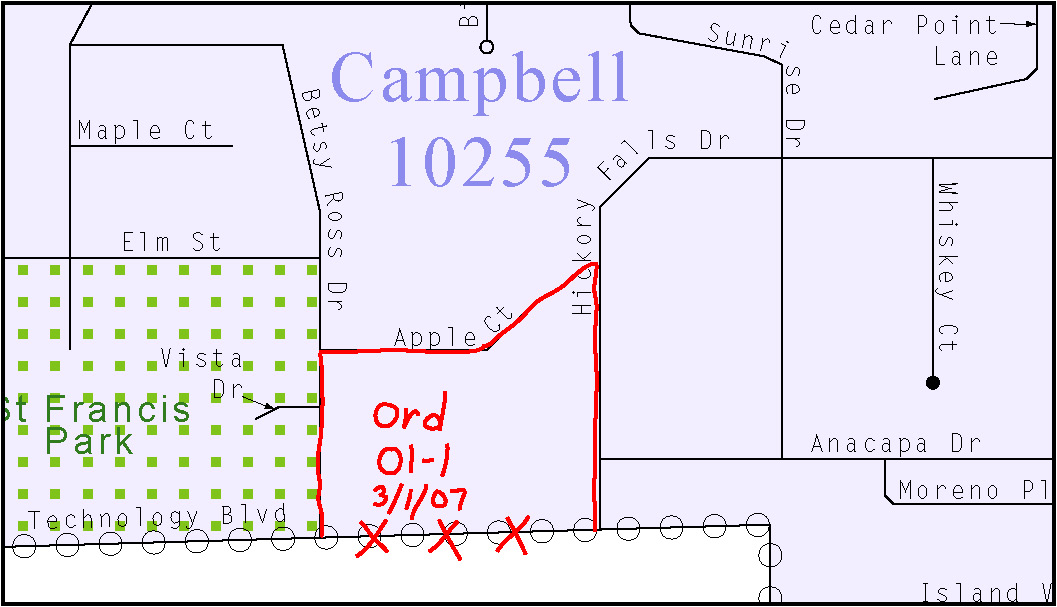
Example 2.2.3.1: This figure illustrates how to make a complete legal boundary change where the boundary is closed as opposed to Example 2.2.3.2.
Incomplete Boundary
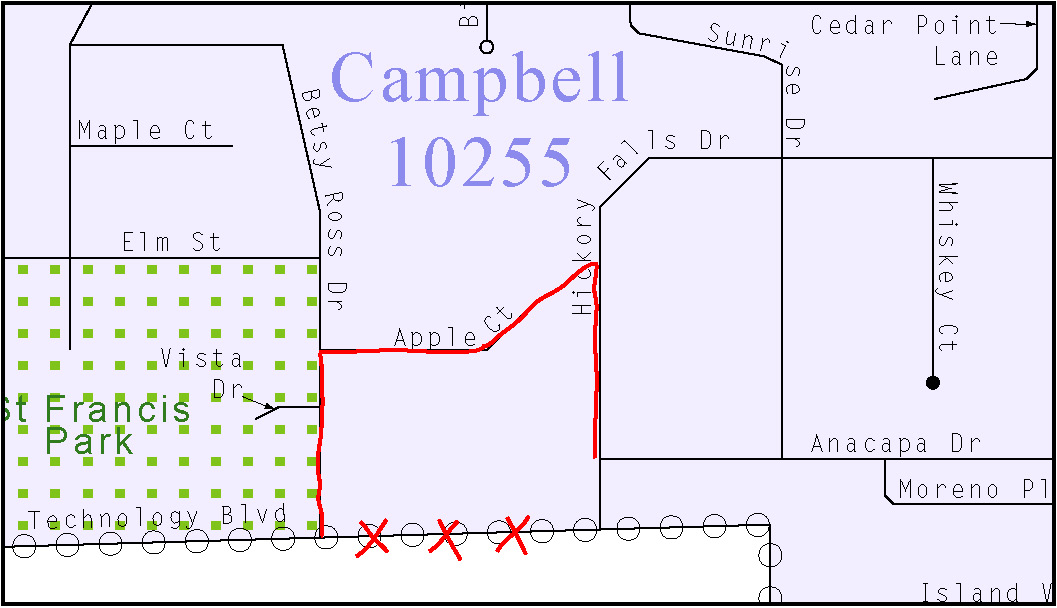
Example 2.2.3.2: This figure illustrates a common error where a respondent did not completely close their boundary or provide ordinance number and effective date of change.
BAS-1 form for Incorporated Places respondents
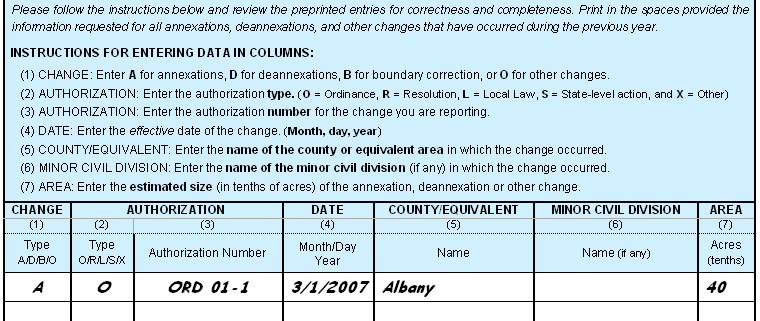
Example 2.2.3.2: Updating boundary changes on the BAS-1 form when reporting for an incorporated place
BAS-2 form for County respondents
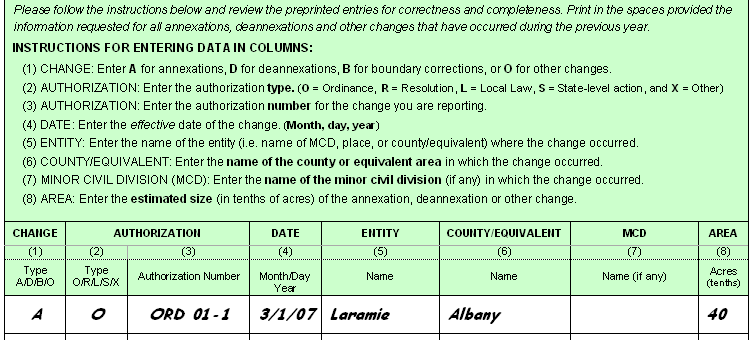
Example 2.2.3.3: Updating legal boundary changes on the BAS-2 form when reporting for a county
BAS-3 form for MCD respondents
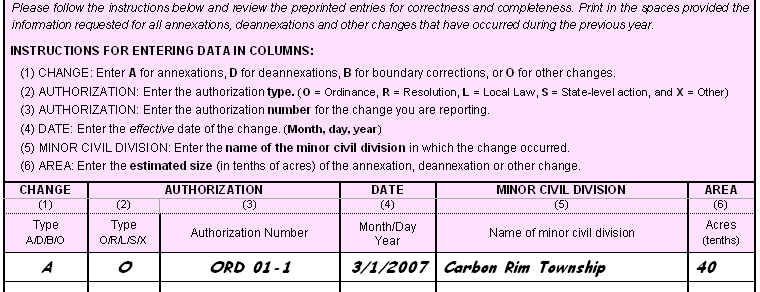
Example 2.2.3.4: Updating legal boundary changes on the BAS-3 form when reporting for an MCD
2.2.4 Legal boundary with coincident feature change
This figure illustrates how to make a legal adjustment to a boundary that is coincident with a feature, such as a street. Using the red pencil, cross out the portion of the boundary that is no longer current using a string of “Xs” inside circles. Add the ordinance number or other legal identifier of the action authorizing the change along with the effective date of each annexation or de-annexation. Document these changes on the BAS form appropriate for your government (incorporated place, county or MCD) as shown in the following figures.
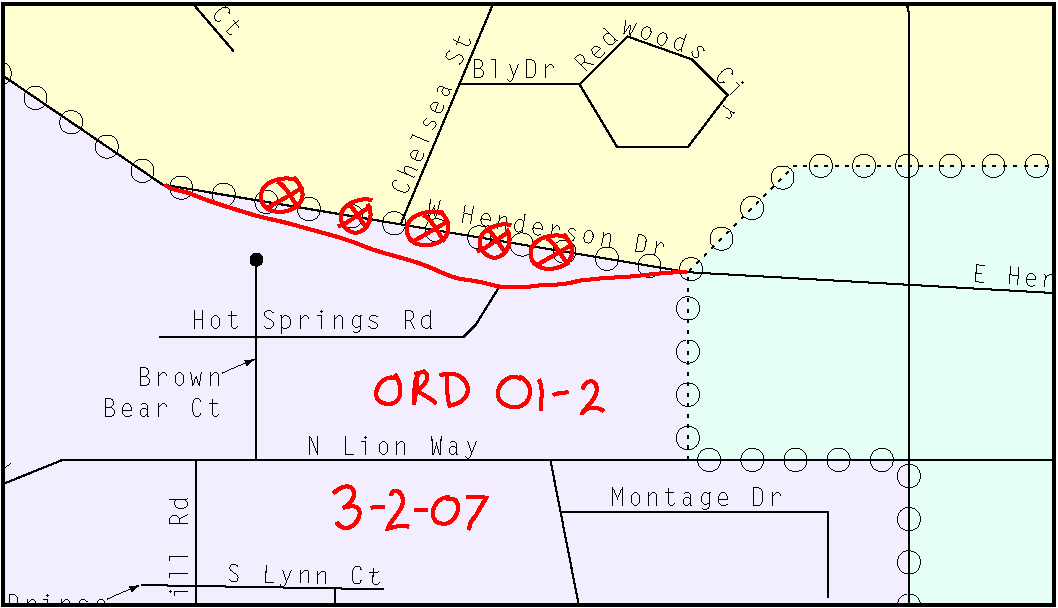
Example 2.2.4.1: Making a change to an incorporated place boundary coincident with a road feature
BAS-1 form for Incorporated Places respondents
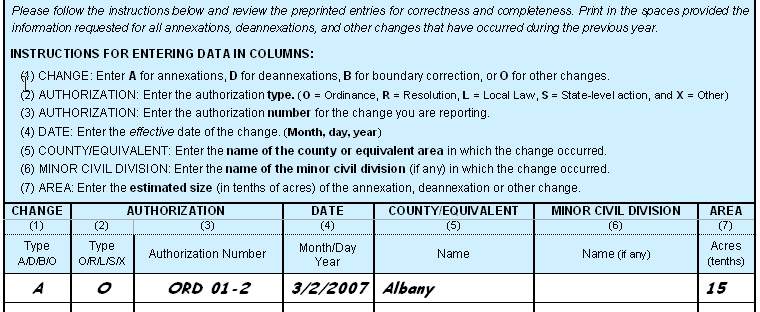
Example 2.2.4.2: Updating the BAS-1 form for an incorporated place boundary change
BAS-2 form for County respondents
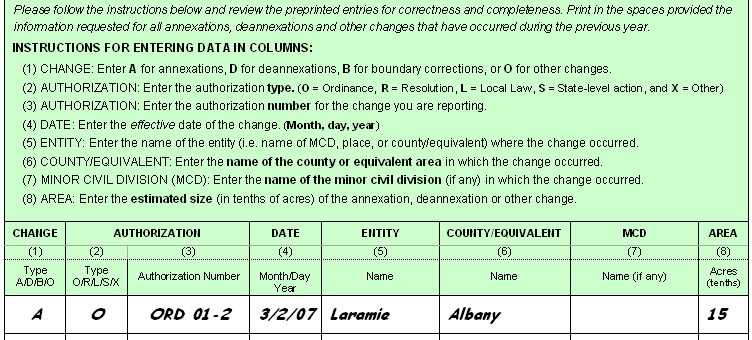
Example 2.2.4.3: Updating legal boundary changes on the BAS-2 form when reporting for a county
BAS-3 form for MCD respondents
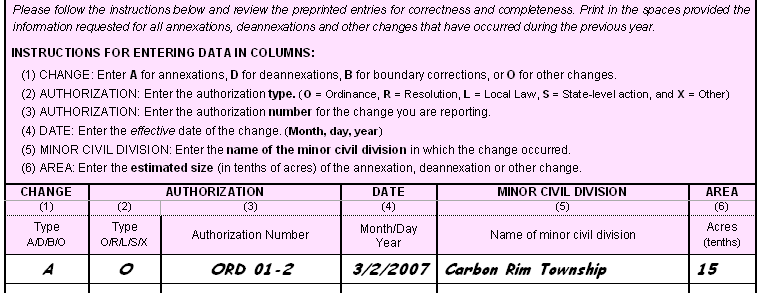
Example 2.2.4.4: Updating legal boundary changes on the BAS-3 form when reporting for an MCD
This figure illustrates how to complete a boundary correction on the map and BAS form. Boundary corrections do not require legal documentation. A boundary correction generally improves the representation of the legal boundary. Do not report a previous year’s annexation or de-annexation as a boundary correction.
Using the enclosed red pencil provided, you will cross out the incorrect boundaries with a string of “Xs”, add a line showing the correct boundary and print the letters “BC” as shown in the figure below, to identify the change as a boundary correction rather than a legal change. Document these changes on the BAS form as shown in the following figures.
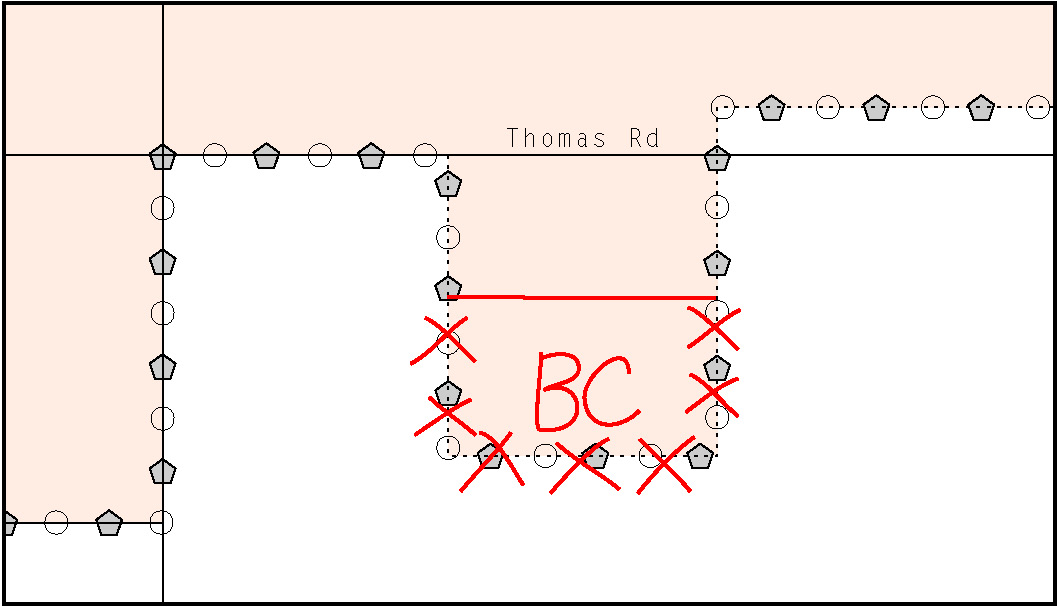
Example 2.2.5.1: Making a boundary correction
BAS-1 form for Incorporated Places respondents
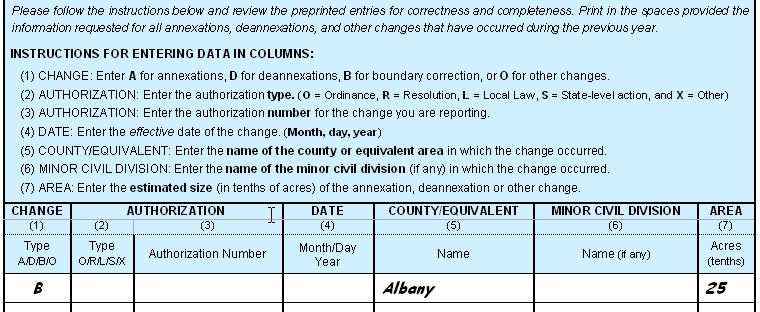
Example 2.2.5.2: Updating the BAS-1 form for a boundary correction
BAS-2 form for County respondents

Example 2.2.5.3: Updating the BAS-2 form for a boundary correction to a county
BAS-3 form for MCD respondents
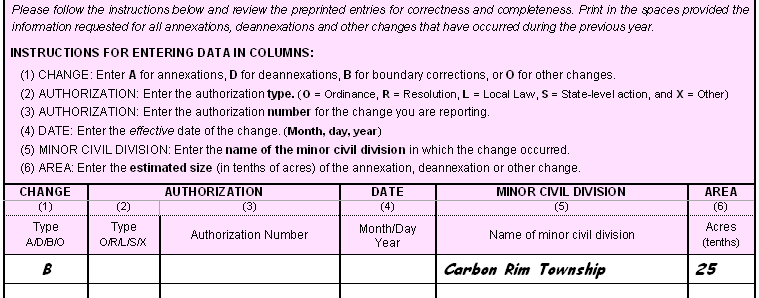
Example 2.2.5.4: Updating the BAS-3 form for a boundary correction to an MCD
This figure illustrates how to make feature modifications that may or may not be coincident with a boundary. Using the purple pencil, you will cross out the incorrect feature location with “Xs”. Draw the feature in the correct location, and print the name of the feature as shown in the figure below.
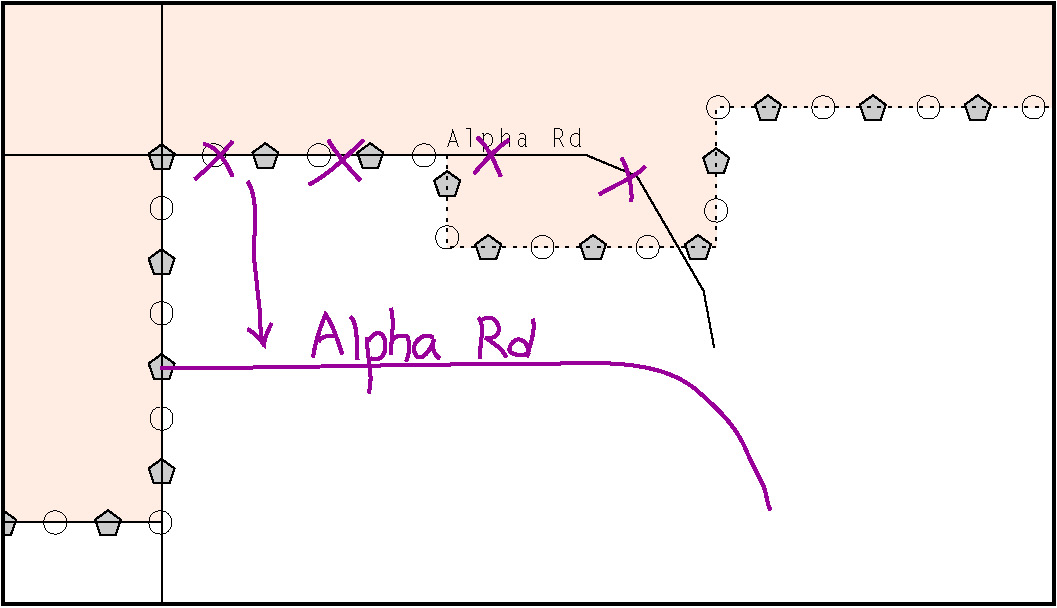
Example 2.2.6: Making a feature modification to a road that is partially coincident with a boundary
Note that adding features internal to the boundary of your incorporated place, county or MCD are not required as part of the BAS. This is also true for other features as streams, point features or areal features. If you choose to provide these, please see sections 2.2.7 through 2.2.11.
2.2.7 Inserting point and area features
This figure illustrates how to insert point and/or area features, including mountains and airports. Using the purple pencil, draw the feature in the correct location, and print the name of the feature as shown in the figure below.
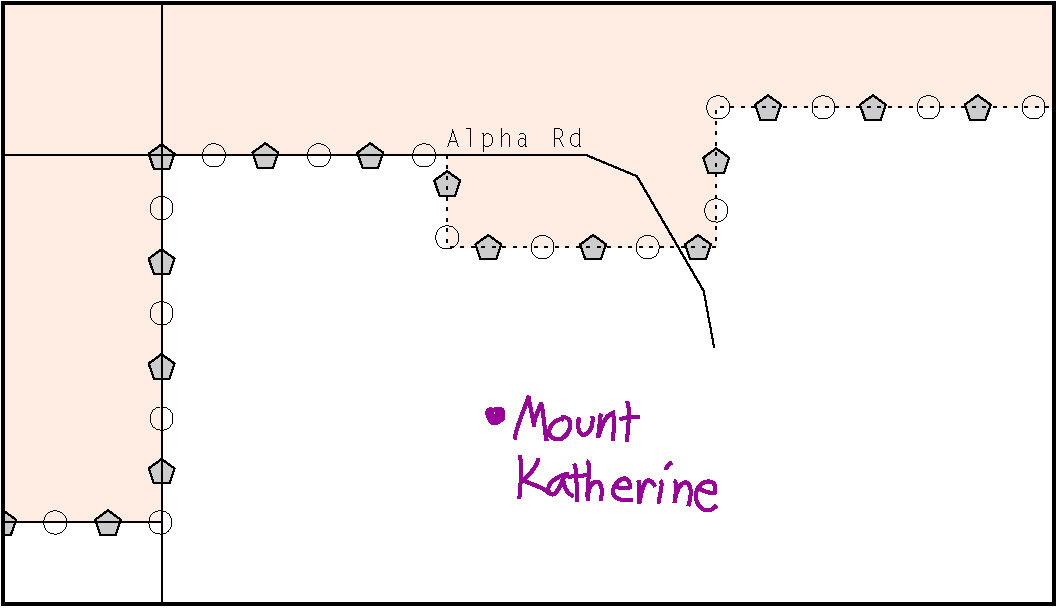
Example 2.2.7.1: Adding a mountain, point feature
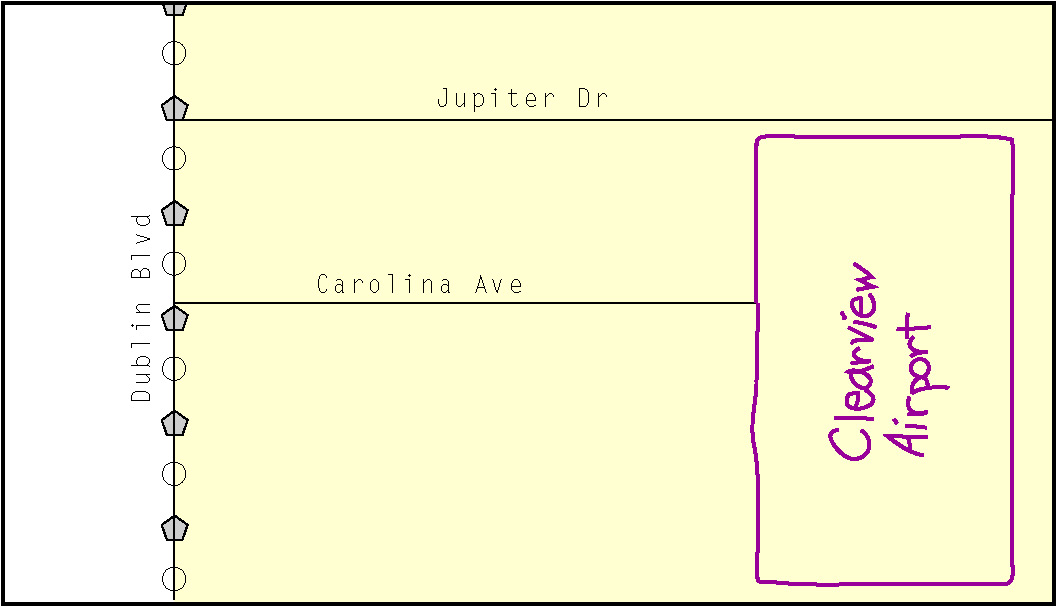
Example 2.2.7.2: Adding an airport, area feature
2.2.8 Edits to street information
This figure illustrates how to add missing streets, new streets, alternate street names and address information.
When adding a missing street, new street, or other feature on the map, use the purple pencil to draw the feature and its name on the map, as shown in the figure below.
If you know an alternate street name, print the alternate in parentheses as shown in the following figure.
Provide the lowest or highest addresses that could be assigned to a road where the road intersects a boundary as shown in the following figure.
If the street has addresses, please provide the name of a source for those addresses on the Address Source Information Worksheet included on the last page of this guide.
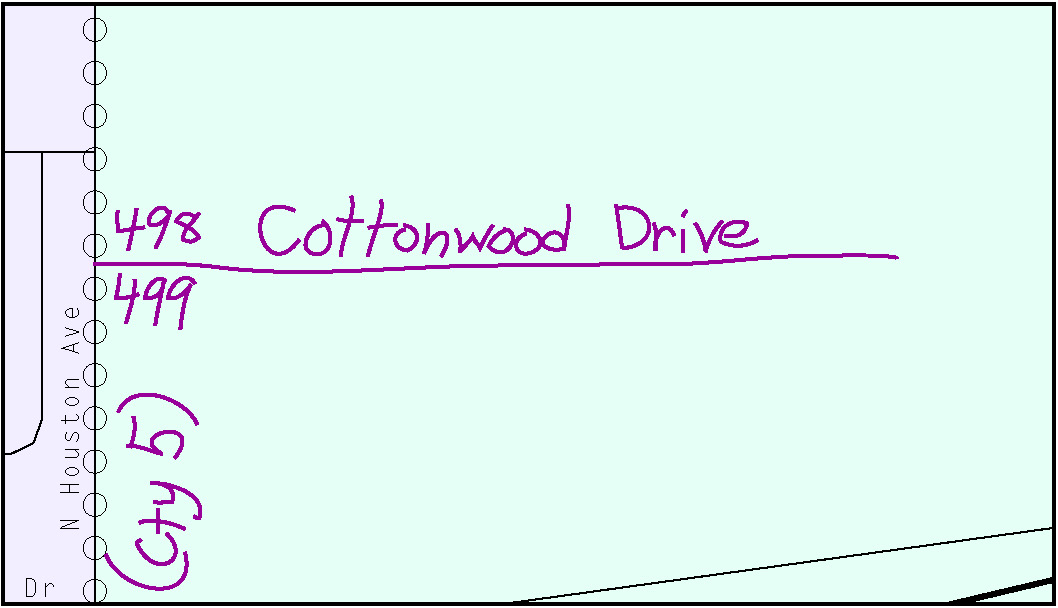
Example 2.2.8: Adding a road feature with annotation, address breaks and an alternate road name
2.2.9 Adding feature names in a congested area
This figure illustrates how to add feature names to a congested area on the map. Using the purple pencil, draw the features onto the map. If the area is too congested to add all feature names on the map provided, number each feature and list this number and the corresponding feature name in the map margin or an uncongested spot close to the feature’s actual location as shown in the following figure. Please do not repeat numbers on a map sheet.
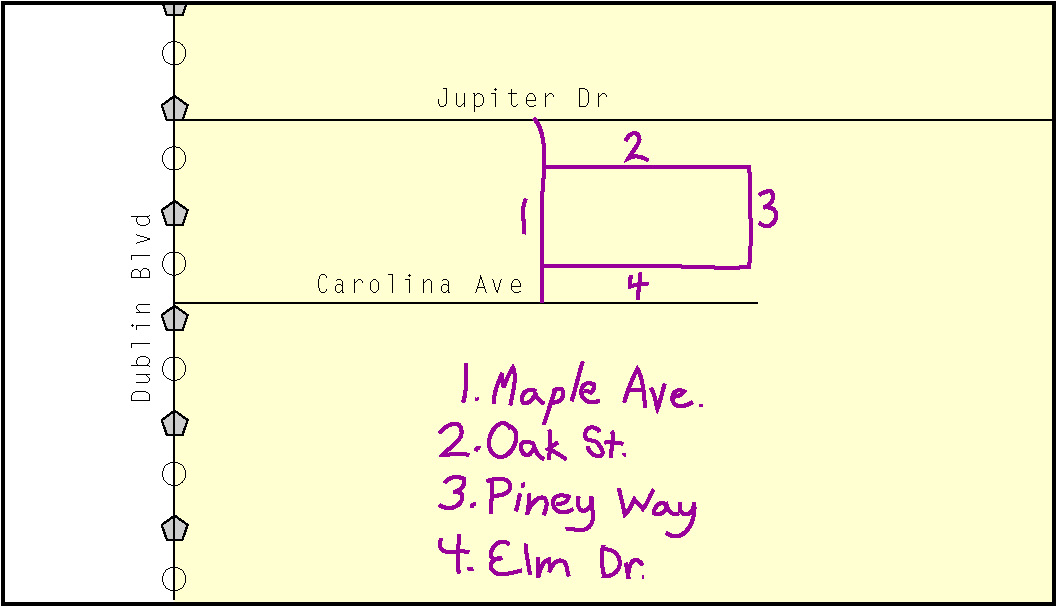
Example 2.2.9: Adding street name features in a congested area
2.2.10 Correcting feature location
This figure illustrates how to correct a feature location.
Using the purple pencil, cross out the existing feature on the map, and draw the feature in the correct location. Draw an arrow pointing to the correct feature location. Label the feature with the feature’s name.
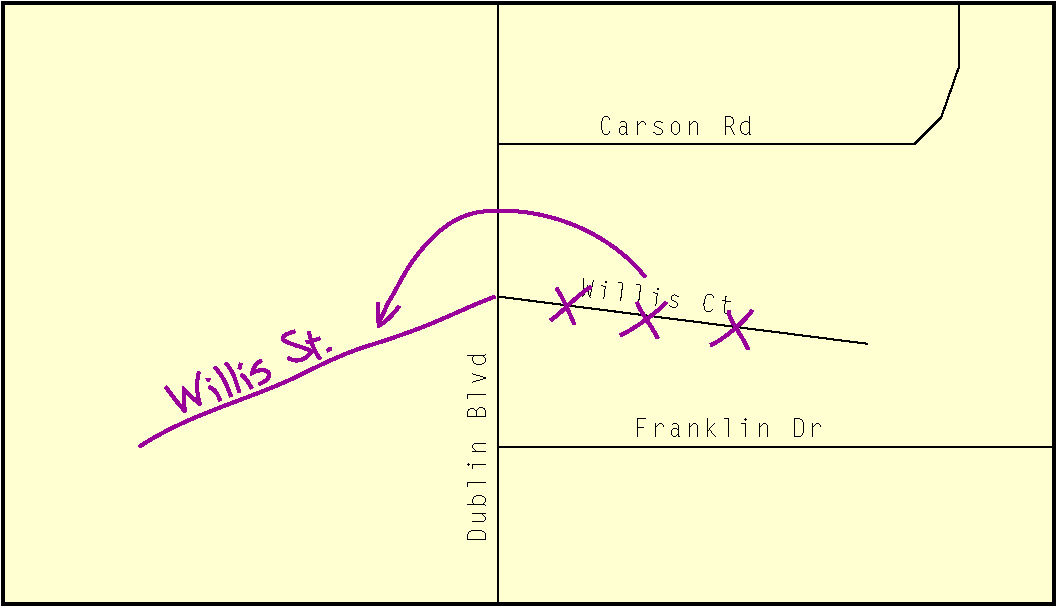
Example 2.2.10: Correcting the location of a street feature
2.2.11 Correcting feature name
This figure illustrates how to correct a feature name. Using the purple pencil, draw a line through the incorrect feature name. Print the correct feature name next to the original name as shown in the following figure.

Example 2.2.11: Correcting a street feature name
2.2.12 Annotating address range breaks
The BAS maps show the last address stored in our geographic database for each street that crosses the boundary of your jurisdiction. These addresses are shown because it is important that the Census Bureau assigns the correct addresses to each governmental unit. Since the BAS only targets addresses at the boundary, the Census Bureau has other operations that are designed to collect address information.1
If any of the following circumstances exist, use the purple pencil to add the last address along a street where it intersects the current boundary:
Annexation or de-annexation was reported
Our depiction of your boundary was corrected
A street was added that crossed a boundary
Our depiction of the address is incorrect

Example 2.2.12: Adding a street feature and annotating with the name and address breaks
This figure illustrates how to delete a feature. Delete only if a feature is nonexistent or if a street is impassable. Do not delete a street because your jurisdiction is not responsible for maintaining it.
Mark the beginning and end of the base feature to be deleted with hatch (//) marks perpendicular to the feature as shown below. Cross out what is to be removed using a string of “Xs”.

Example 2.2.13: Deleting a street feature
2.2.14 Adding a cul-de-sac or circle
This figure shows how to correctly represent a cul-de-sac or circle with illustrations of each symbol and corresponding aerial photographs. The photographs are provided to show the difference between cul-de-sacs and circles. A cul-de-sac is paved, whereas, a circle has an area of unpaved ground within it.
To add a cul-de-sac or circle, draw the feature using the purple pencil following one of the following sketches. Print the name of the associated street leading to the cul-de-sac or circle.
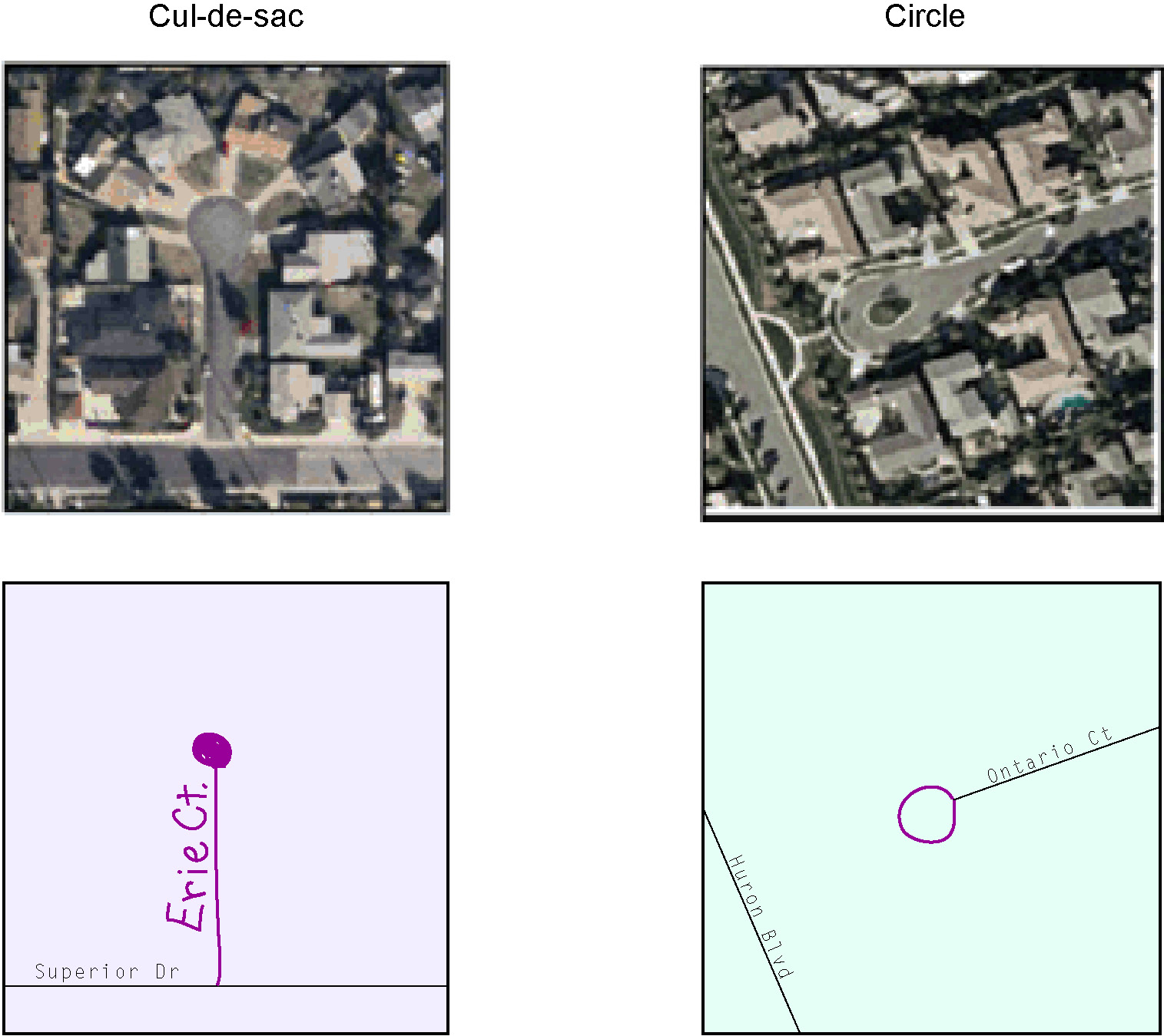
Example 2.2.14: Adding cul-de-sac and circle features with annotations
2.2.15 Designating a geographic corridor to a street feature
This figure illustrates how to display a geographic corridor (a corridor that occurs on both sides of a road).
A geographic corridor is an area that only includes road surface and right-of-way and does not contain any structures addressed to either side of the road. The Census Bureau geocodes addresses based upon the centerline. There are two types of geographic corridors:
An area where a road, or other feature is not incorporated by a place
An area where a road, or other feature, is the only piece of incorporated place
To indicate a geographic corridor on your map, use the red pencil to draw a line on each side of the road. Mark the beginning and end of each line with perpendicular hatch marks. Write the letters “GC” beside each line.

Example 2.2.15: Designating a geographic corridor to the north and south of the street feature
2.2.16 Designating a geographic offset to a street feature
This figure illustrates how to display a geographic offset (a corridor on one side of the road).
A geographic offset is an area claimed by an entity that is only on one side of the road and does not include any structures addressed to that side of the road. The Census Bureau geocodes addresses based on the centerline of roads. If your boundary is not coincident with the centerline but follows the parcel line, and the addresses along the road should be in your jurisdiction, you need to report a geographic offset. By coding the offset the addresses will be assigned to the correct geography.
To indicate a geographic offset on your map, use the red pencil to draw a line parallel to the road on the side where the offset exists. At the beginning and end of the offset draw double hatch marks. Write the word “Off” near to the line.
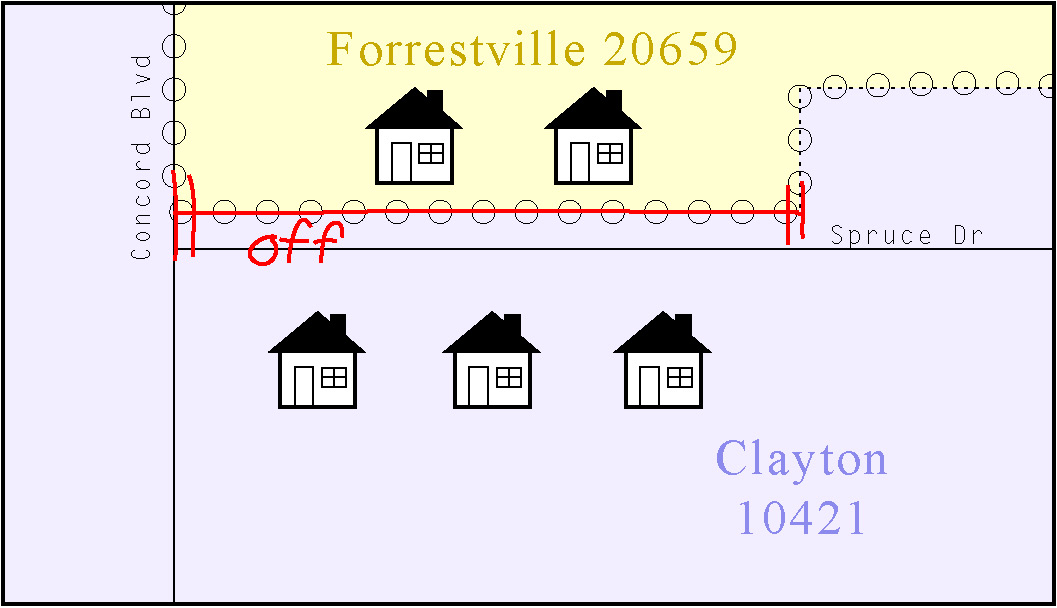
Example 2.2.16: Designating a geographic offset to the north of the street feature
If you find unnamed road segments on the maps, please provide the road names, if known, using the purple pencil or label them as “PR” if these are unnamed private roads. Examples of private roads are driveways and unnamed roads in commercial or industrial parks.

Example 2.2.17: Adding unnamed road features with annotation
For each map sheet that has changes, fill in the Signature Box on one copy of the map:
Print the date, your name, position and phone number
Sign your name
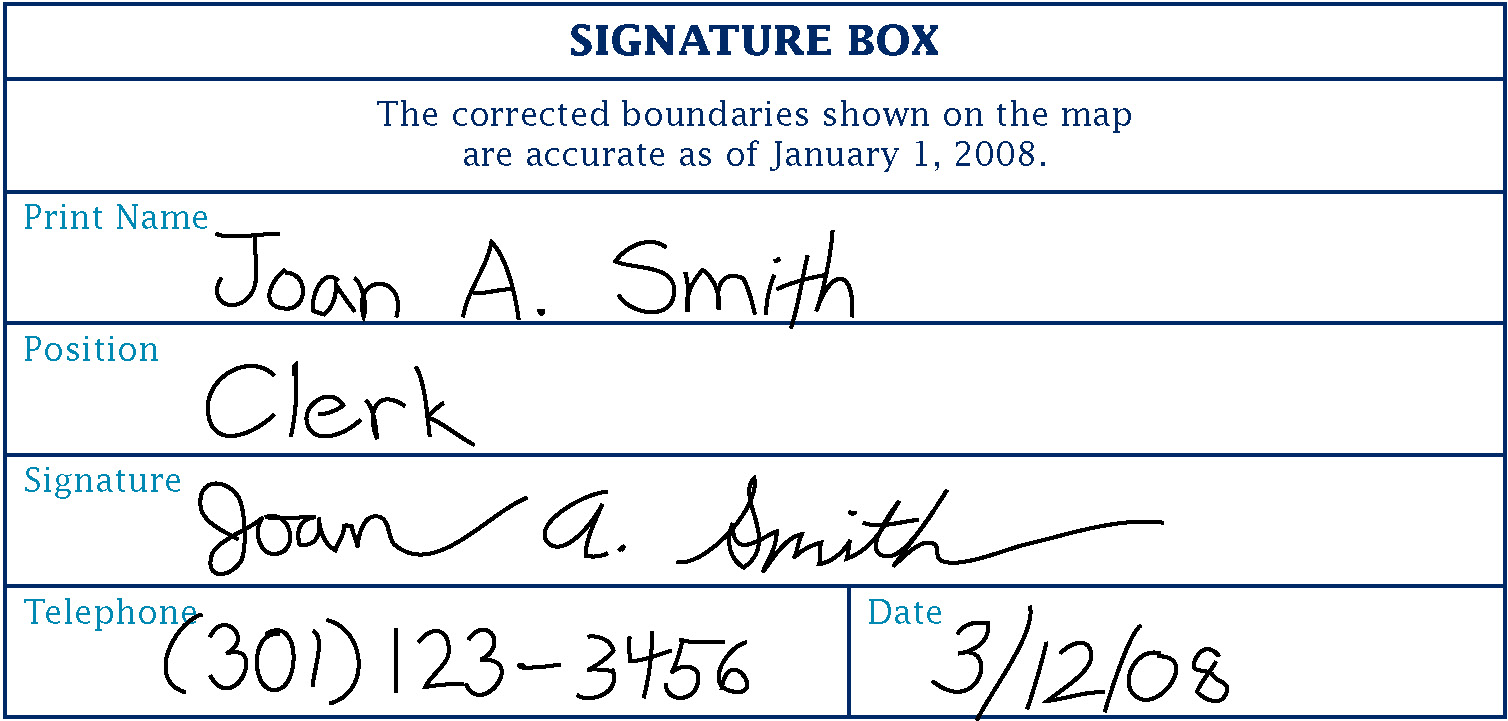
Example 3.0: Completing the signature box on the map sheet
Use the postage-paid envelope to return the set of signed maps and the BAS form to the Census Bureau. If after reviewing the BAS forms and maps it is determined that you do not have any changes to report, sign the “No Change” postcard and return it to the Census Bureau.
Appendices
Appendix 1: Paperwork Reduction Project
The U.S. Census Bureau estimates that the BAS review will take most respondents from 1 to 6 hours to complete. This includes the time needed to read the instructions, assemble materials, organize and review the information, and report any needed changes. This estimate is based on 80 percent of all areas having few or no changes. However, for areas with many changes it may take 20 hours or longer to complete the survey. Please send comments regarding this burden estimate or any other aspect of this collection of information, including suggestions for reducing this burden to:
Paperwork Project 0607-0151
U.S. Census Bureau
4600 Silver Hill Road
Room 3K138
Washington, DC 20233
Or you may e-mail comments to:
Note: use “Paperwork Project 0607-0151” as the subject.
Please include a copy of your message addressed to:
Appendix 2: State arrangements and agreements
The following the states have special arrangements or agreements with the Census Bureau for conducting the BAS. There agreements are described in the special notes below. Additional agreements may be posted to our BAS website if they are finalized after printing this guide.
Alaska
California
Georgia
Kentucky
Louisiana
Michigan
Minnesota
New York
Puerto Rico
Virginia
West Virginia
Wisconsin
Alaska
Alaska Statutes (AS 29 and AS 44) stipulate the Local Boundary Commission be involved in the development of all boundary changes to incorporated places including annexations, incorporations, or dissolutions. The Local Boundary Commission within the Alaska Department of Commerce, Community and Economic Development has designated the Alaska Department of Labor and Workforce Development as the agency to provide the Census Bureau with boundary changes through the annual Boundary and Annexation Survey.
The Census Bureau and the Alaska Department of Labor and Workforce Development are working together to consolidate the updates of legal boundaries in Alaska. This ensures the Census Bureau will obtain the boundary information it needs from a single source.
Please note that any governmental boundary changes, incorporations, dissolutions, and mergers for your borough or city effective on or before January 1st, will be submitted by the Alaska Department of Labor and Workforce Development.
If you have any questions or concerns regarding legal boundaries for your borough or city you may contact Ingrid Zaruba at 907-465-2439 or by email at: [email protected]
California
The California State Board of Equalization serves as the Certifying Official for all local governments in California. The Board certifies to the Census Bureau the legality of boundary changes made by California municipalities. To assist them, please enter the final resolution number adopted by the city council as approved by the Local Agency Formation Commission (LAFCO) for each boundary change in the Authorization Number field on the BAS Entity Update Form. Do not report the resolution number that initiated the action. Also, please enter the date on the certificate of completion issued by the LAFCO in the Effective Date field on the BAS Entity Update Form.
Georgia
The Georgia Code stipulates that all annexations and deannexations to incorporated places be reported to the Georgia Department of Community Affairs. The Census Bureau has an ongoing working relationship with this state agency to conduct the annual Boundary and Annexation Survey. A list of entities that reported boundary changes to the Georgia Department of Community Affairs is provided to the Census Bureau each year. The Census Bureau uses this list to determine who should get a BAS package.
Please ensure that all annexation and deannexation information has been reported to the Department of Community Affairs, per the Georgia Code. The Georgia Code is available at http://www.legis.state.ga.us/. You may report your boundary changes to the Department of Community Affairs online or print a boundary change report form at http://www.georgiaplanning.com/annex.htm. Printed forms can be mailed to Annexation Reports- Georgia Department of Community Affairs- 60 Executive Park South, NE- Atlanta, Georgia- 30329-2231.
The Department of Community Affairs (DCA) serves as the Certifying Official for all local governments in Georgia. DCA certifies to the Census Bureau the legality of boundary changes made by Georgia municipalities. To assist them, please enter the final resolution or ordinance number adopted by the city for each boundary change, as it was reported to DCA. If no resolution or ordinance number was assigned by your city then use the DCA-ID number assigned by DCA to your annexation report. Enter the number in the Authorization Number field on the BAS Entity Update Form. Also, please enter the effective date, as officially recorded by DCA; into the Effective Date field on the same form. The DCA-ID number and official effective date for annexations can be obtained at http://www.GeorgiaPlanning.com/annex.htm. If you have any concerns about this data, contact Terry Jackson at 404-679-4946.
The Census Bureau has also entered into a cooperative agreement with the State of Georgia Municipal Association to provide two sets of maps to each government surveyed through the BAS. Please return one set of maps to the Census Bureau; the other set can be marked and retained for your records.
Kentucky
The Kentucky Revised Statutes stipulate that all boundary changes to incorporated places within Kentucky be reported to the office of the Secretary of State. Reports of boundary changes are forwarded by the Secretary of State to the Division of Geographic Information for mapping. The Census Bureau has an ongoing working relationship with this state agency to conduct our annual Boundary and Annexation Survey. The Kentucky Division of Geographic Information provides a list of incorporated places, which reported boundary changes, to the Census Bureau each year. The Census Bureau uses this list to determine who should get a BAS package.
Please ensure that boundary change information has been reported to the Office of the Secretary of State, per the Kentucky Revised Statutes. The Kentucky Revised Statutes are available at http://www.lrc.ky.gov/statrev/frontpg.htm. All boundary changes should be submitted to The Land Office Division, Secretary of State, Room T40, Capitol Annex, 700 Capital Ave., Frankfort, KY, 40601.
If you would like to review the data, which the Kentucky Division of Geographic Information has for your entity, please visit http://kygeonet.ky.gov/. If you have any concerns about this data, contact Kim Anness at 502-564-1450.
Louisiana
The MCD used in Louisiana for Census Bureau data tabulations is the parish governing authority district. These districts are the same as the Police Jury Districts or the Parish Council Districts used for the election of members of the police jury or parish council. Please review the boundaries of the parish subdivisions in your parish carefully to ensure that the names and boundaries conform to these districts. Do not report election precincts or election districts or any other areas that are not used in apportioning the representatives of the police jury or parish council. If you have a question about which MCDs you are to report, please contact:
Bill Blair
Director of Demographic Services (House and Senate)
P.O. Box 44486
Baton Rouge, LA 70804
Telephone: 225-342-2591
Fax: 225-342-0768
E-mail: [email protected]
If you report changes or corrections to the districts in your parish, please ensure that you also report the effective date of the change.
Michigan
Michigan law stipulates that all boundary changes to incorporated places and minor civil divisions within Michigan be reported to the office of the Secretary of State. The Census Bureau has an ongoing working relationship with a state agency to conduct our annual Boundary and Annexation Survey. The state agency provides a list of incorporated places and minor civil divisions, which reported boundary changes, to the Census Bureau each year. The Census Bureau uses this list to determine who should get a BAS package.
Minnesota
Minnesota statutes stipulate that all boundary changes to incorporated places and minor civil divisions within Minnesota be reported to the office of Strategic and Long-Range Planning. The Census Bureau has an ongoing working relationship with a state agency to conduct our annual Boundary and Annexation Survey. The state agency provides a list of incorporated places and minor civil divisions, which reported boundary changes, to the Census Bureau each year. The Census Bureau uses this list to determine who should get a BAS package.
New York
The New York Department of State, Division of Corporations and State Records serves as the Certifying Official for all local governments in New York. The Division certifies to the Census Bureau the legality of boundary changes made by New York municipalities. Please be advised that the state can certify only those boundary change actions enacted by Local Law pursuant to Section 714 of the General Municipal Law. To assist them, please enter select “L – Local Law” from the Authorization Type drop down to indicate that this action is a local law. Enter the final Local Law number for each boundary change in the Authorization Number field on the BAS Entity Update Form, rather than the municipal ordinance or resolution number that initiated the action. Finally, please enter the date the annexation was filed with the Secretary of State in the Effective Date field on the same form.
Puerto Rico
Under Puerto Rico law, boundary changes to municipios and barrios are reported to the Census Bureau by the Puerto Rico Planning Board only. The Puerto Rico Planning Board will report all boundary changes, approved by the Puerto Rico Government, effective on or before January 1 of each year
The Census Bureau and the Puerto Rico Planning Board collaborate to consolidate the updating of legal boundaries at the commonwealth level, after they have been approved by the Puerto Rico Legislature. The Planning Board maintains the most up-to-date boundary information for all municipios and barrios in Puerto Rico.
If you would like to review the boundary data that the Puerto Rico Planning Board has for your municipio and/or barrios, please visit http://www.jp.gobierno.pr. If you have any concerns about this data, contact Ms. Lillian Torres-Aguirre at 787-723-6200 ext. 2501.
Virginia
The minor civil divisions (MCDs) used in Virginia for Census Bureau data tabulations is the district used for the election of a representative to the County Board of Supervisors. These districts usually are termed magisterial districts, but can have other designations, such as election or supervisor districts. Please review the boundaries of the MCDs in your county carefully to ensure that the names and boundaries conform to the areas functioning as districts for the election of county supervisors.
Do not report taxing districts, districts used for the recording of land titles, or any other type of district that is not used in apportioning the representatives of the county board. If these districts are not called magisterial districts, put the correct description of the areas above the first data line showing the “NAME OF MUNICIPALITY OR MINOR CIVIL DIVISION” in Question 3. If you have a question about which MCDs you are to report, please contact:
U.S. Census Bureau
Geography Division
Geographic Entity Programs Branch
Legal Areas Team
Washington, DC 20233-7400
Telephone: 301-763-1099
Fax: 301-457-4710
E-mail: [email protected]
If you report changes or corrections to the districts in your county, please ensure that you also report the effective date of the change.
West Virginia
The MCD used in West Virginia for Census Bureau data tabulations is the magisterial district. Magisterial districts are the divisions of the county used for the election of county commissioners and members of the school board. Please review the boundaries of the county subdivisions in your county carefully to ensure that the names and boundaries conform to the areas called magisterial districts. Do not report taxing districts, districts used for the recording of land titles, or any other type of district that is not used in apportioning the representatives of the county board. If you have a question about which MCDs you are to report, please contact:
Patricia Hamilton
Certified Association Executive
West Virginia Association of Counties
2211 Washington Street East
Charleston, WV 25311
Telephone: 304-346-0591
Fax: 304-346-0592
E-mail: [email protected]
If you report changes or corrections to the districts in your county, please ensure that you also report the effective date of the change.
Wisconsin
Wisconsin law stipulates that all boundary changes to incorporated places and minor civil divisions within Wisconsin be reported to the office of Secretary of State. The Census Bureau has an ongoing working relationship with a state agency to conduct our annual Boundary and Annexation Survey. The state agency provides a list of incorporated places and minor civil divisions, which reported boundary changes, to the Census Bureau each year. The Census Bureau uses this list to determine who should get a BAS package.
Appendix 3: Census Bureau Regional Offices - Contact Information
|
Atlanta Regional Office 101
Marietta Street, N.W., Ste. 3200 (404) 730-3832 or (800) 424-6974 TDD: (404) 730-3964 FAX: (404) 730-3835 E-mail: |
Detroit
Regional Office (313) 259-1158 or (800) 432-1495 TDD: (313) 259-5169
Fax:
(313) 259-5045 |
|
|
Boston Regional Office 4 Copley Place, Ste. 301 P.O.
Box 9108 (617) 424-4500 or (800) 562-5721 TDD: (617) 424-0565 FAX:
(617) 424-0547 |
Kansas
City Regional Office (913) 551-6728 or (800) 728-4748 TDD: (913) 551-5839
Fax:
(913) 551-6789 |
|
|
Charlotte
Regional Office (704) 424-6400 or (800) 331-7360 TDD: (704) 344-6114 Fax:
(704) 424-6944 |
Los
Angeles Regional Office (818) 267-1700 or (800) 992-3530
TDD:
(818) 904-6249 |
|
|
Chicago
Regional Office Oak Brook, IL 60523-1918 (630)
288-9200 or (800) 865-6384 |
New
York Regional Office New York, NY 10014 (212) 584-3400 or (800) 991-2520 TDD: (212) 478-4793 Fax: (212) 478-4800 E-mail: |
|
|
Dallas
Regional Office Dallas, TX 75247 (214) 253-4401 or (800) 835-9752 TDD:
(214) 655-5363 |
Philadelphia
Regional Office (215) 717-1800 or (800) 262-4236 TDD: (215) 717-0894
Fax:
(215) 717-0755 |
|
|
Denver
Regional Office (303) 264-0202 or (800) 852-6159 TDD:
(303) 969-6767 |
Seattle
Regional Office (206)
381-6200 or (800) 233-3308 Fax
(206) 381-6310 |
|
Address Source Information Worksheet
Entity Name ___________________________________________________________________
Title of Source _________________________________________________________________
Publisher of the Source __________________________________________________________
Publication Date ________________________________________________________________
Type of Source (paper, digital file, internet, etc) _______________________________________
Additional Information _________________________________________________________
Source Contact Information
Please provide the contact information of where the source can be obtained.
Name _________________________________________________________________________
Phone Number __________________________________________________________________
Address _______________________________________________________________________
________________________________________________________________________
________________________________________________________________________
Email Address __________________________________________________________________
Other __________________________________________________________________________
Source Evaluation Checklist
|
YES |
NO |
Does the source contain the names and addresses for all street features affected by the boundary? |
|
|
Does the source contain address range breaks where the streets intersect or meet with the boundary? |
|
|
Does the source show which sides of the streets contain the even and odd addresses? |
|
|
Are there other current map and address reference sources available for use by the Census Bureau? |
|
|
1 If you have a reliable source for addresses within your jurisdiction and would be willing to share that information with the Census Bureau, we request that you fill out the Address Source Information Worksheet found on the last page of this guide. BAS staff will forward the updated form to the address update staff with the information you provide about the source. The correct assignment of addresses to jurisdictions is of primary importance to our censuses and surveys. If the street has addresses, please provide the name of a source for those addresses on the Address Source Information Worksheet. Provide the lowest or highest addresses that could be assigned to a road where the road intersects a boundary. [get clarification on this from Laura, Mike or Bernadette]
| File Type | application/msword |
| Author | Bureau Of The Census |
| Last Modified By | Bureau Of The Census |
| File Modified | 2007-05-16 |
| File Created | 2007-04-06 |
© 2025 OMB.report | Privacy Policy
